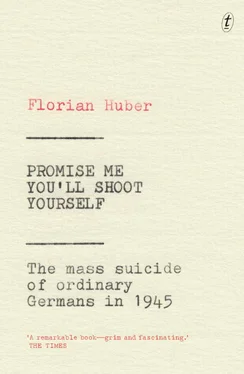• • •
On 6 May, Marga Behnke, the daughter of the cemetery gardener, began to keep a record of the suicides in Demmin. On this day alone, the first day of mass burials, she made thirty-four entries, and for more than nine weeks afterwards she kept daily records. Here and there a name or date has been added in her mother’s handwriting. Rather than use the official register, they recorded everything in the cemetery nursery’s slim black receipt book. The names and origins of the dead (insofar as they were identifiable) were entered in the column headed Lieferer or ‘supplier’. The next two columns were reserved for as precise a record as possible of the day and the manner of death. When this information could not be established, as was often the case with the drowned bodies, Marga Behnke had to make do with registering an unknown woman, man, boy or girl. Refusing to consign hundreds of people to anonymity and oblivion, she noted even the slightest clue to a person’s identity: the initials on a handkerchief, a red blouse, a missing index finger.

Cemetery nursery receipt book
On the twenty-eight pages of this improvised death register, which they kept until 15 July, Marga and her mother recorded the deaths of more than six hundred people, most of whom had either committed suicide or, in the case of children, died along with their parents. More than half, many of them refugees or unidentified, were buried in a mass grave, including the family of schoolteacher Gerhard Moldenhauer, who had shot at the Soviets from his window after killing his wife and children. Many other residents of Demmin, though, were buried in individual graves—the furrier Herr Wockersin and his family, for example, who had drowned themselves in the Trebel; Gustav Sembach, the forester, who had shot himself in the head and died of the wound some time later; and military vet Dr Melzer and his wife, who had poisoned themselves in Deven Wood. Often it was dependants of the deceased who arranged for them to have graves of their own. The Kuhlmanns’ family maid, Else, ends her account of the family’s demise as follows:
Another thing I should like to tell you, my dear Werner, is that your mother and Ilse were buried in a grave in the cemetery. Your father couldn’t be recovered from the rubble, because there was too big a fire in the dispensary. Your mother and Ilse were found in the ruins of the dining room, their bodies charred. I have put a cross on their grave. I’m afraid it’s only a wooden one, but it can always be replaced at a later date.
In the black receipt book, Marga Behnke had at first listed Werner’s father, Dr Kuhlmann, under grave no. 240, after his wife (grave no. 238) and daughter (grave no. 239). Eventually, though, when his body wasn’t found, she had to strike ‘veterinary surgeon’ off the list.
• • •
Official record keeping of the recent events in Demmin also began at about this time. On 19 May, Sorge, the registrar, opened a makeshift office, because the old town hall had been reduced to a gaping facade. As the death records from 1945 had burnt along with everything else in the registry office, Sorge had to begin at the beginning and start his records at number one. He received long lines of husbands and wives, mothers and fathers, sons and daughters, uncles, nieces, mothers-in-law and grandmothers who had survived, and came to Sorge to register their relatives’ deaths. Sometimes it was neighbours or friends who came to him; sometimes people whose connection to the dead was in no way obvious. Within two weeks, Sorge’s figures had soared into the hundreds, though some deaths weren’t reported until weeks or even months after the event.
All through that summer and far on into the autumn, Sorge the registrar listened to the grim stories of death in Demmin. In many cases, the misery of the survivors overshadowed even the horrors suffered by the dead. On 25 May, Elfriede Schultz, whose son-in-law had already been missing for some time, came to report the suicide of her daughter and grandchild. The death of three-year-old Gerd Wedhorn in a canal was registered by his mother, whose own suicide attempt had evidently failed. A musician reported that his wife had drowned herself and their child in Swan Pond. On 12 June, Marie Büchner told Herr Sorge of the deaths of her son, daughter-in-law, grandchild and three other members of her family, who had all been found together, hanged.
On the one-page death certificates on which the registrar set his seal, he recorded, sometimes in the spiky Sütterlin script then common in Germany, the dead person’s age, denomination, place of residence and birth, and marital status. He recorded the place and time of death and noted down the personal details of the individual reporting the case. There was no space on the form, however, for the circumstances of death, let alone the cause or motives. Herr Sorge seemed to regard this as unsatisfactory, and began to add postscripts such as ‘Death by suicide (hanging)’ to the final time-of-death section. Before long, he had switched to inserting footnotes at the bottom left-hand side of the page. If, at first, Sorge restricted himself to the single word ‘suicide’, he was soon elaborating on this: ‘suicide by hanging’, ‘suicide by poison’, ‘suicide by slit wrists’, ‘suicide by shooting’, ‘killed by mother’, ‘killed by parents with poison’. Sometimes he intimated the nature of an individual’s death by replacing the word ‘deceased’ with the expression ‘found dead’. Such minor tweaks allowed the registrar to pull aside the curtain of bureaucratic formalism and give a glimpse of the events of those days.
On 19 October, he signed the last two suicides reported to him: numbers 926 and 927, the wife and youngest son of senior medical officer Dr Herbst. By this point Sorge had heard, recorded and certified almost two hundred deaths. The few that followed bear the signature of a different clerk.
Part II
DEMMIN IS EVERYWHERE

A Voice from the Bombed-out Temple
The vicar of Kaiser Wilhelm Memorial Church on Berlin’s Kurfürstendamm was an unassuming-looking man, with his narrow shoulders, narrow face and receding chin. His shy-looking eyes peered out through round glasses, and his moustache was as sparse as the hair on his head—a pale parody of the Führer’s famous toothbrush. But Gerhard Jacobi was by no means as timid and cautious as he appeared. As head of the oppositional Confessing Church, he had been taking a stand against the regime for twelve years, and had often been mocked, arrested or beaten up for his convictions. He himself was merciless with his congregation, insisting that they face up to the many contemporary horrors challenging them as Christians.
One Sunday in early March 1945, Jacobi preached against one of the archenemies of life and soul—suicide. In the congregation was Danish newspaper correspondent Jacob Kronika, who regularly combed Berlin’s churches in search of dissenting voices that spoke out above the drone of official rhetoric. He felt strangely moved by the powerful sermon Jacobi gave that morning. It seemed to him somehow out of place in that particular parish.
The Kaiser Wilhelm Memorial Church, a many-towered monument to empire in the western centre of the capital, had suffered repeated bombings. The roof over the nave had fallen in and the tip of the spire snapped off. It stood there, gutted, like a pile of gnawed and broken bones, a boarded-up, bombed-out temple—but a considerable crowd had gathered for the service nevertheless, in draughty makeshift premises. ‘The parish hall was bursting,’ Kronika said. He saw a flock of believers undeterred by air raids and winter weather, and observed: ‘Something of a sense of their fighting spirit can be felt in the way they sing.’
Читать дальше














